Last Friday, I spent a day on the warpath with Brian Schoeneman, a candidate for Virginia House of Delegates in Fairfax, Virginia. We followed the steps of Robert E. Lee’s Maryland Campaign (1862) and the crucial battles at South Mountain, Harpers Ferry, and Antietam. Although Brian has spent the past decade in politics, he is also passionate about history, which explains why he was eager to let me do an informal interview focused on the past. During our time together, he revealed his diverse reading list, his interest in Civil War politics, and his desire to plant a Virginia state monument at Antietam.
Fairfax: Where Lee decided to invade
We started the journey at Brian’s home in Fairfax, which is in the same region where Lee made his decision to invade the North nearly 149 years ago. I laid out maps of the battlefields along with Lee’s “liberation” proclamation to Maryland on the table. Brian’s foyer suddenly became a war room as we discussed Lee’s strategic dilemma in September 1862 and the decision to invade. Before we began the trip, I took an inventory of the other artifacts in the room–replicas of china used by early presidents, a bust of Washington, a volume of Theodore Roosevelt’s writings, a book on the fall of Carthage, and, appropriately, a book containing the wartime correspondence of Lee.
South Mountain: What are your sources for learning history?
When we arrived at South Mountain, we visited the small, yet rich museum dedicated to the battle. There, a park volunteer walked us through the events of the battle. Coincidently, he turned out to be a retired fireman from Fairfax.

From there, we headed to the various gaps of South Mountain where the fighting took place. At Crampton’s Gap, I asked Brian if he had a regular source for history. He immediately mentioned Hardcore History, a podcast by Dan Carlin whose latest episode is part of a series on the fall of the Roman Republic. Other than that, Brian mostly relies on books, digital ones at least. He lamented the fact that he tends to avoid books nowadays when they are not available on the Kindle.
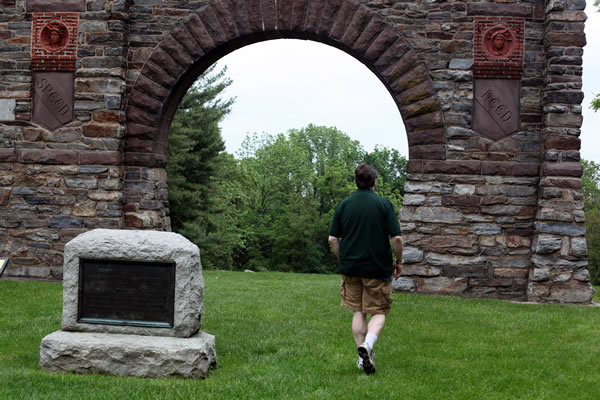
As for his favorite Civil War authors, he cited Shelby Foote and Michael Shaara, but “the best Civil War book I’ve read is McPherson’s, because I’m interested in not simply the battles and the military side of things, but I’m interested in the politics of the time.” He was referring to the Battle Cry of Freedom, which he is now reading for the third time. Brian then continued to stress the importance that politics played in the start of the war, an aspect that a lot of “scholarship tends to gloss over.” Politics before the war are important to Brian, as he believes all wars “are a fundamental breakdown in the political system that made resolving conflict impossible without bloodshed.” He sees the Civil War as being no different. It is “what happens when the system is broken and there is no way to fix it. Given the realities of the time period and how the cultures had evolved, there was no way to fix the problems within the current framework of the government, which is why things had to change. And they did, but it took a war.” For Brian, McPherson’s book makes this point clear.
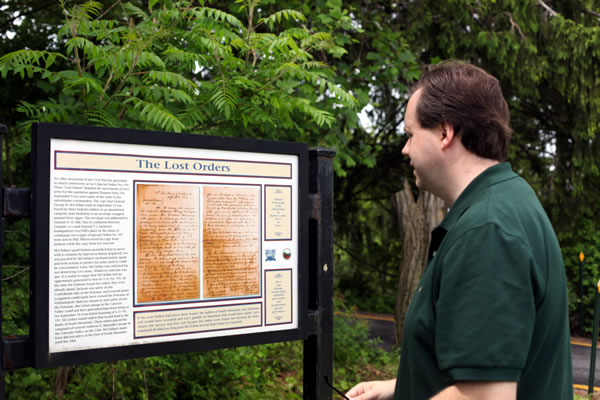
Antietam: How does the Civil War influence your daily work?
After we visited all the gaps at South Mountain, we drove to Antietam, paid our six-dollar fee, and headed north to the Cornfield, an area where there were roughly 13,000 casualties. A familiar scene occurred when Brian got another call about the campaign. This time, it had something to do with the latest flyer design. When he got off the phone, he looked around and asked, “Where’s the corn?” A ranger later explained that it would not be in full effect until August or September.
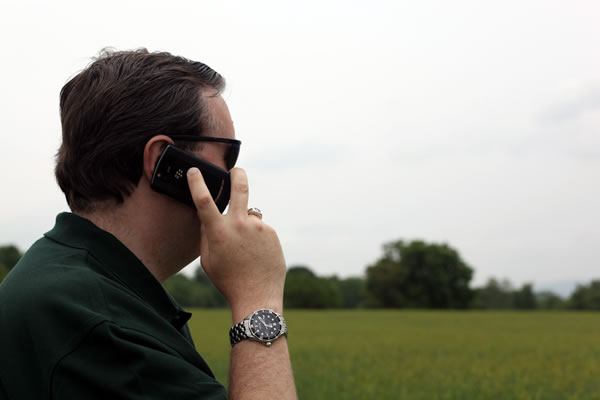
We made our way to the bloody lane and began trekking through the aptly named spot. Brian was amazed at how well hidden the sunken road was from anyone approaching from the north.
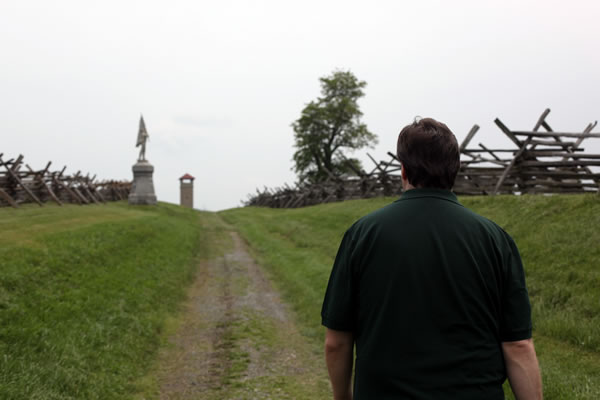
We took a break from the battlefield to eat some lunch. I asked Brian what influence the Civil War has on his daily work. “History, particularly Civil War history, is fundamental to being a Virginian. The echoes of the war are felt for any of us who live in the state,” he explained. He pointed out the close proximity of his house to the Manassas battlefield. “Fairfax was a major crossroads in the war. Both armies crossed the region several times.”
“True, but how does any of that affect your job?”
“The Thirteenth, Fourteenth, and Fifteenth Amendments were some of the most important and critical changes to our system of government, particularly the Fourteenth Amendment. Most of today’s modern constitutional jurisprudence flows from the Fourteenth Amendment, which wouldn’t have been possible without the war.” Brian went on about the importance of understanding how these laws came about and stressed that too many people complain about laws that may not make sense today, but made plenty of sense at their inception. He believes people would benefit from learning the history of the laws, not simply what they say or mean.
Burnside Bridge: What is the value of visiting Civil War battlefields?
After lunch, we headed toward Burnside Bridge, the scene where several hundred Georgians held off assaults from a corps of Union troops before withdrawing due to low ammunition and the threat of a flank attack. I asked what value Brian saw, if any, for other Americans to visit places like Antietam and South Mountain. “My philosophy is that history becomes more real when you can put yourself in the shoes of the folks who lived it. Visiting battlefields, seeing museums, seeing the actual tools they used–it gives you a better understanding of the enormity of what this was like. That can only enrich your sense of belonging, your sense of being a part of something bigger than yourself, which is the United States.” There is more to it than that, however. Even people who are not necessarily interested in what occurred in the battlefields can enjoy some of the “most beautiful” parks in the country. “I remember when my wife was pregnant,” he recalled. “We would go down to the Manassas battlefield. It was good exercise for her and it was beautiful. We had a chance to stroll along and enjoy the history, but we had a chance to enjoy the outdoors as well.”
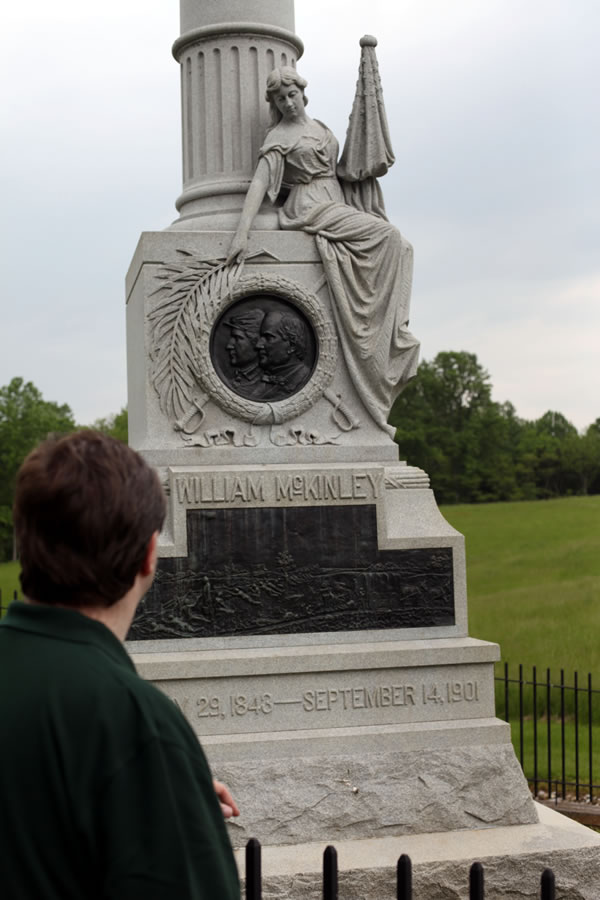
A. P. Hill Arrives: Where is the Virginia state monument?
After we spent some time at Burnside Bridge and the Georgian Lookout, we headed toward the final scenes of the battle where A. P. Hill and his troops arrived just in time from Harpers Ferry to save Lee’s army from obliteration. We searched in earnest for a monument for Virginia, but only found a small one dedicated to the army as a whole. We asked a ranger about the general lack of Confederate monuments. He explained that most southern states lacked the funds after the war to place any monuments.
I asked Brian if he was surprised at the lack of Confederate monuments. “Actually, I am. It kinda annoys me. There are about a zillion Union monuments here. Granted, the North took more casualties at Antietam, but they had more guys to lose.” He recalled one of the informational markers he read, “The Army of Northern Virginia lost about a quarter of their strength and the Army of the Potomac lost about an eighth. It was much harder for the South to replace those casualties than it was for the North.” Brian clarified that, if elected, he planned to introduce legislation next year to place a Virginia state monument on the battlefield in commemoration of the sesquicentennial. I pointed out that such a move could backfire if not done properly and he interrupted me, “There’s nothing political about recognizing that folks in the army of the state that I’m from fought here and died here. They deserve to be remembered regardless of what side they fought on and it bothers me there is nothing here, because I know there are plenty at Gettysburg.”
Brian said I could quote him on that.
Lee’s Retreat: What is on your reading list?
On our drive home, I asked Brian a very practical question that revealed a lot about the candidate, “What are the last three books you read?” He mentioned one and then turned on his iPad to give me an accurate list—How Rome Fell by Adrian Goldsworthy, and two books about the American Revolution, Almost a Miracle and A Leap in the Dark by John Ferling. As for his current readings, he cited The Grand Strategy of the Byzantine Empire by Edward Luttwak, The Hundred Years War by Desmond Seward, and of course, The Battle Cry of Freedom. While I would expect any American politician to read books about the Revolution and the Civil War, I am surprised and refreshed to hear of one who also reads about medieval and ancient wars.
On the way back to Fairfax, we discussed the dismal situation of Lee’s army after Antietam and the effect of the Emancipation on the war. We also managed to review the latest designs for his political flyers, which he had been finagling with throughout the day. Having never lived in Virginia, I had little to contribute to his campaign discussions. However, I can at least attest to Brian’s interest in history ranging from the days of the Roman Republic to the Civil War, which would impress me about any person.
